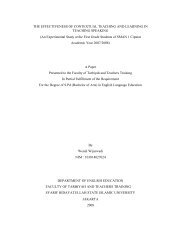Contextual Teaching And Learning
 Contextual Teaching And Learning
Contextual Teaching And Learning
How We Teach

What is the best way to teach so that all students can use and retain information? How can a teacher communicate effectively with students who wonder about the relevance of what they study? These are the challenges teachers face every day–the challenges that a curriculum and an instructional approach based on contextual learning can help them successfully address.
The contextual approach recognizes that:
- Learning is a complex, multi-faceted process that goes beyond drill-oriented, stimulus-and-response methodologies.
- Learning occurs when learners process new information in such a way that makes sense to them in their own frame of reference.
- The mind naturally seeks meaning in context, in relation to a person's environment, doing so by searching for relationships that make sense and appear useful.
What is Contextual Learning? CORD, 2016
Why Teach Contextually?
Why use contextual strategies?
- Adult students don't want to learn in a vacuum.
- Understanding real-world connections to course content increases student engagement which often leads to increased persistence and successful transitions.
Contextual Classroom Environment
A contextual approach supports best practices for reaching adult learners. A contextual approach:
- Encourages design of learning environments that use multiple teaching modalities and incorporate different forms of learning experiences.
- Allows learners to discover meaningful relationships between abstract ideas and real-world applications.
- Enables concepts to be internalized through discovery, reinforcement/modeling, and problem-solving.
- Provides ongoing feedback that promotes further learner interaction with content.
- Engages learners and motivates them to persist.
Contextual Classroom Environment - A Contrast CORD, 2016
Are You Teaching Contextually?
Are you teaching contextually? Take this self-test and see.
Are You Teaching Contextually? CORD, 1999 [updated 2016]
The REACT Strategy
CORD's REACT strategy is based on contextual learning methods. Curricula and instruction based on contextual learning should be structured to encourage five essential student engagement strategies: Relating, Experiencing, Applying, Cooperating, and Transferring.
Characteristics of learner engagement with the REACT strategy:
Relating - Learning in the context of one's life experiences or pre-existing knowledge.
Experiencing - Learning by doing, through exploration, discovery, and invention.
Applying - Learning by putting skills to use.
Cooperating - Learning through sharing, responding, and interacting with others.
Transferring - Using knowledge in a new context or novel situation.
The REACT Strategy CORD, 2016
Sample REACT Lesson CORD, 2016
Contextual Lesson Design/Templates
Explore contextual lesson design elements by reviewing these contextual lesson templates. Use the templates to practice the development of lessons that allow students to relate, experience, apply, cooperate and transfer as they learn.
Applying the REACT Strategy CORD, 2016
Developing Contextual Units CORD, 2016
Active Learning
"In the traditional approach to college teaching, most class time is spent with the professor lecturing and the students watching and listening. The students work individually on assignments, and cooperation is discouraged. Such teacher-centered instructional methods have repeatedly been found inferior to instruction that involves active learning, in which students solve problems, answer questions, formulate questions of their own, discuss, explain, debate, or brainstorm during class, and cooperative learning, in which students work in teams on problems and projects under conditions that assure both positive interdependence and individual accountability." ----Richard Felder, Professor Emeritus of Chemical Engineering, North Carolina State University
Basic Active Learning Strategies Center for Educational Innovation, University of Minnesota
Active Learning Richard Felder, North Carolina State University
Links to articles discussing Dr. Felder's research on active and collaborative learning and exploring strategies for implementation.
"Active Learning: Creating Excitement in the Classroom" Charles C. Bonwell and James A. Eison, ERIC Clearinghouse on Higher Education, ED340272, 1991
Gallery Contextual Teaching And Learning
 Pembelajaran Ctl Contextual Teaching And Learning
Pembelajaran Ctl Contextual Teaching And Learning
 Contextual Teaching And Learning
Contextual Teaching And Learning
 The Influence Of Learning Using Contextual Teaching And
The Influence Of Learning Using Contextual Teaching And
 Pdf Analysis Of Contextual Teaching And Learning Ctl In
Pdf Analysis Of Contextual Teaching And Learning Ctl In
 Improving Students Motivation In Learning Speaking By Using
Improving Students Motivation In Learning Speaking By Using
 Pdf Contextual Teaching And Learning For Practitioners
Pdf Contextual Teaching And Learning For Practitioners
 Contextual Teaching And Learning
Contextual Teaching And Learning
 Contextual Teaching And Learning A Successful Process For
Contextual Teaching And Learning A Successful Process For
 Pdf Improving Students Writing Abiliy By Using Contextual
Pdf Improving Students Writing Abiliy By Using Contextual
 The Principle Of Contextual Teaching Learning Ctl Proyek
The Principle Of Contextual Teaching Learning Ctl Proyek
 Pdf The Effectiveness Of Contextual Teaching And Learning
Pdf The Effectiveness Of Contextual Teaching And Learning
 Pdf Effects Of Teaching Vocabulary Mastery By Contextual
Pdf Effects Of Teaching Vocabulary Mastery By Contextual
 Contextual Teaching And Learning What It Is And Why It S
Contextual Teaching And Learning What It Is And Why It S
 The Effectiveness Of Contextual Teaching And Learning Idb4
The Effectiveness Of Contextual Teaching And Learning Idb4
 Pdf The Use Of Contextual Teaching And Learning In Writing
Pdf The Use Of Contextual Teaching And Learning In Writing
 Cemink S Voices Contextual Teaching And Learning Definition
Cemink S Voices Contextual Teaching And Learning Definition
 The Effect Of Contextual Teaching And Learning Model Through
The Effect Of Contextual Teaching And Learning Model Through
 Contextual Teaching And Learning Ctl To Improve Students
Contextual Teaching And Learning Ctl To Improve Students
 Contextual Teaching And Learning Ctl In Elt English
Contextual Teaching And Learning Ctl In Elt English







0 Response to "Contextual Teaching And Learning"
Post a Comment